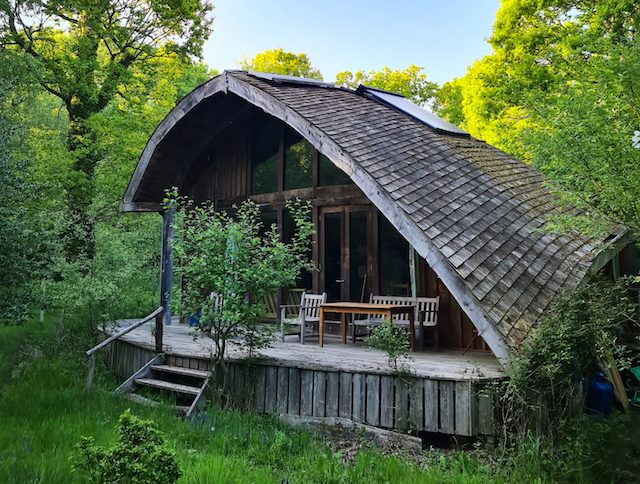In this post I am conducting a thought experiment. My question is, what if we built and maintained our buildings in an a regenerative way? By regenerative, I mean in a way that leaves the ecosystem, in its fullest sense, richer and better able to heal itself.
From its beginning, Hazel Hill has been a centre for education about sustainability. But in the wider environmental movement, the consensus is that we can no-longer afford to just sustain our current ecosystem, we have to restore it a thriving condition. Thus the shift from sustaining to regenerating.
Maintaining the off-grid buildings of our centre is one of our main operational tasks as a charity. So what would a regenerative approach look like to maintaining our buildings?
Let’s consider the job of replacing the decking that surrounds the Forest Ark. This deck, which extends around three sides of the Ark is ten years old. The boards and the supporting joists are starting to reach the end of their life and need replacing.
Maybe sustainable but…
The Forest Ark is one of our most used buildings and so we need to find a quick solution to keep the building in service. The most likely course of action will therefore be to commission a contractor to remove all the old timbers, buy in new timber from a timber merchant and to fit the new decking during a short period of downtime. The work will cost the charity of the order of £10,000, or equivalent to twenty weekends’ hire of the building.
If we source the timber appropriately, power the electrical tools renewably and reuse any waste generated, then you could call this approach sustainable, enabling us to continue with our work running a centre for sustainable education.
But stepping back, this approach leaves the system much less rich than it could be.
- There is no knowledge left in the local system of how to do this work ourselves in future.
- There is no development in understanding of how we could use on-site materials as a resource.
- There is extraction of the materials from another ecosystem and polluting transport to our site.
- The approach will deplete our financial reserves which we may require us to run events more intensively in future, potentially causing more damage to the ecosystem.
- There is little connection formed between the people doing the work and the ecosystem, which opens the ecosystem open to damage.
A regenerative approach
What if this need to replace the decking became an opportunity to leave the ecosystem, including the humans in the local system, more resilient and thriving?
Let’s start with the materials. If we were to source the materials from within our own wood, it could be a trigger to thinking about how trees in the wood could be a regenerative source of timber for the local community. If we had in mind that we were looking for trees that could be a source of timber, we could care for and prepare those trees in a way that makes them suitable for that purpose. It would tune us in to thinking about what the ecosystem can offer and what if can tolerate. If we were to select, cut down and season wood from Hazel Hill we could involve people in this process, sharing and developing local knowledge in the process.
Rather than bringing in a contractor to do the work, why not bring in a trainer to train people in how to do the work? Rather than pay a third party to do the work, and then recoup the costs through renting the facilities – a transactional relationship – why not charge to attend a training course that improves the facilities and increases knowledge – a transformational relationship.
Locked in to the old system
The reason why we can’t easily take this regenerative approach is that we are not configured as an organisation to operate in this way. We have bookings to fulfil, and these help pay for our buildings maintenance.
But interestingly, as we seek more bookings, the standards that these groups demand increases and we are more and more locked into the behaviours associated with the extractive economy rather than being regenerative.
I share these thoughts publicly because I feel they are symptomatic of a wider challenge that we face in society. We know on the one hand that we are living beyond our planetary boundaries, but scarcity and fear keeps us locked in to the existing, destructive ways of acting.
I am scared that if we don’t get this deck replaced quickly then the loss of revenue to the charity will be big. And yet, we are surrounded by the abundance that nature could provide, and the opportunity to find mutual wealth through collaborative working and learning.
To make that leap requires us to be able to see and hold that vision of abundance and to take brave steps towards that vision in spite of the fear that scarcity brings.
This is the sort of approach that we need right across our communities and economy. Why shouldn’t it start right here, with how we maintain our buildings? With how we replace our deck?

